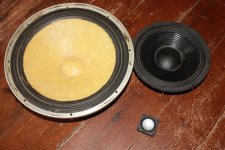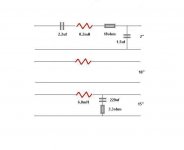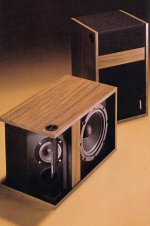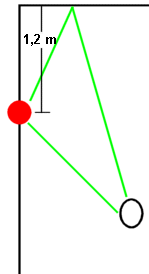Lookie lookie ! Graaf, he shall be your next victim ! 
Having the Q15s located on the floor and angled upward I mostly noticed no difference in height compared to the big speakers (accountable to quality differences) so I'm not quite convinced about the impact of floor bounce on height perception.
Sitting behind my laptop in the otherwise dark listening to Dead Can Dance I can't really tell the location of the speakers. I still have to build the "omni-directional" floor cubes but I think they'll be able to create a believable soundstage while being invisible.
Lookie lookie ! Graaf, he shall be your next victim !
I'm afraid it'll take a whole lot to beat my open baffles though.
I'm afraid it'll take a whole lot to beat my open baffles though.
The Gate?
The Gate, open baffle 4 tower loudspeaker system!
indeed it's difficult to beat something that took 37 years of development
I hope that it will not take another 37 years to beat it, 3.7 years realistically
I hope that it will not take another 37 years to beat it, 3.7 years realistically
Well, the next design I have in mind (and the panels are ready and waiting) will only add to the years. :-D
.....................................Greater than 14 feet to "front" wall...................................
.......................................................................................................................
.......................................................................................................................
..............................................500 Hz up Cardioid................................................
.........................................<L..18 inches separation..R>...............10 feet to sidewall
......................................................................................................................
........................................2 feet forward of 500 Hz up.........................................
.........................................50 Hz to 500 Hz Cardioid............................................
....................<L........................9 feet separation............................R>.................
......................................................................................................................
......................................................................................................................
..................................Listener 7 feet forward of 500 Hz up...................................
...................................................(Listener)......................................................
......................................................................................................................
......................................................................................................................
......................................."Rear" wall 10 feet behind Listener..................................
Notes:
500 Hz Cardiods are *radial* "point source".
500 Hz up are at ear height.
Below 500 Hz are line arrays
.......................................................................................................................
.......................................................................................................................
..............................................500 Hz up Cardioid................................................
.........................................<L..18 inches separation..R>...............10 feet to sidewall
......................................................................................................................
........................................2 feet forward of 500 Hz up.........................................
.........................................50 Hz to 500 Hz Cardioid............................................
....................<L........................9 feet separation............................R>.................
......................................................................................................................
......................................................................................................................
..................................Listener 7 feet forward of 500 Hz up...................................
...................................................(Listener)......................................................
......................................................................................................................
......................................................................................................................
......................................."Rear" wall 10 feet behind Listener..................................
Notes:
500 Hz Cardiods are *radial* "point source".
500 Hz up are at ear height.
Below 500 Hz are line arrays
Last edited:
Sounds interesting, Scott! And now the psychoacoustic principles behind those requirements please.
..and just how many books do you think I'll write?
errr.. most of the reasoning can be "pieced together" from some of my posts in the "omni" thread, and also in the "stereolith" thread.
Low IACC (interaural cross correlation) between channels including reverberant energy near the average.
Increased pressure left of left and right of right to compensate for hearing loss at 90 degree horizontal angles while maintaining low IACC.
Wall distances further from upper freq. speakers than from listener to speaker - eliminates most confusion relating to reverberant energy from reflections.
Increased front wall distance from speaker to improve depth sensation (..which is otherwise difficult to reproduce in a compelling fashion). The increased delay/phase rotation of the "front" wall reflection does this.
Last edited:
............. (...)
...............
Notes:
500 Hz Cardiods are *radial* "point source".
500 Hz up are at ear height.
Below 500 Hz are line arrays
relatively simple for an advanced side-firing setup, at least in comparison to Radugazon's system
tested?
Last edited:
tested?
No.
In some respects yes, but not fully.
Even if I currently had the time and access to proper equipment, (which I don't), I don't have the engineering skill to get the design fully "there".
Point source radial cardioid at high freq.s.. that's a "tough nut to crack".
I have done this up to about 1.5 kHz however.
I've also played with the Neo 8's for the higher freq.s, but never could get an acceptable absorption of the rear wave while maintaining the overall radiation profile.. plus I wasn't fond of the tight vertical pattern. Like you, I'd rather an upward firing high freq. solution - i.e. radial.
Last edited:
What's wrong with "tough nut" soffa pillow? 
First you test, by any means necessary to get a result, then only try to make it practical. That's the way to do research.
- Elias
First you test, by any means necessary to get a result, then only try to make it practical. That's the way to do research.
- Elias
Point source radial cardioid at high freq.s.. that's a "tough nut to crack".
No Cabinet,
drivers lying on the floor ?
Then i must have built lots of ceiling flooders, just for breaking
drivers in ...
well, it is clear that despite my sincere efforts Your understanding of the subject is still... still... ...eeer... very limited
So the "ideal directivity pattern" speaker bounces the majority of its treble off the side walls, forces strong early lateral reflections has its direct sound suppressed and give 8 ms delay between treble and bass?
I don't think so.
Come back Bose 301. All is forgiven.
David S.
I don't think so.
Come back Bose 301. All is forgiven.
David S.
Attachments
So the "ideal directivity pattern" speaker bounces the majority of its treble off the side walls, forces strong early lateral reflections has its direct sound suppressed and give 8 ms delay between treble and bass?
I don't think so.
Come back Bose 301. All is forgiven.
David S.
majority of its treble? strong early lateral reflections and direct sound suppressed at the same time? 8 ms delay between treble and bass? Bose 301?
c'mon!
it looks that either You are unfair or You are the same case as LineArray - very limited understanding of the subject
the latter I find hard to believe...
so... please be fair!
Of course discussion of perception thresholds for aspects of group delay
and reflection seems rather pointless, unless you manage to design a speaker/room
system which provides at least a few milliseconds of clearly dominant direct sound
to the listener.
no problem, flooder in Beveridge placement provides for >8 ms of clearly dominant direct sound to the listener even in a narrow relatively small room
clearly the way to go for RFZ-believers
You would need to place the flooder at least 1.2 m in front of the front wall to achieve that - without any big reflecting piece of furniture along that 1.2 m. That should be no big problem - just a reminder.flooder in Beveridge placement provides for >8 ms of clearly dominant direct sound to the listener even in a narrow relatively small room
The big remaining problem IMHO would be the wildly different frequency content of the direct vs. ceiling-reflected sound.
Attachments
Hi,
10ms free zone after the direct sound can be achieved easily in 25 m2 living room with on wall line array.
On the other hand, in my experience with 'flooder' and the stereolith style sound projectors, the direct sound has no meaning. It's strange but that's how it seems to be. Hearing works in a way that the perceived direction skips the first sound if immediately followed by stronger sound. When I placed 2-way box speaker on the floor aimed towards ceiling and listened at 2m distance I cannot localise the speaker on the floor, but the sound appeared to come in front, further back than the front wall. This is total opposite what I perceive if I place the box normally at the ear height facing listener whereas I only hear the sound coming from the speaker.
Mathematically the group delay is in anomaly, but hearing processing does not seem to care about it at all.
- Elias
10ms free zone after the direct sound can be achieved easily in 25 m2 living room with on wall line array.
On the other hand, in my experience with 'flooder' and the stereolith style sound projectors, the direct sound has no meaning. It's strange but that's how it seems to be. Hearing works in a way that the perceived direction skips the first sound if immediately followed by stronger sound. When I placed 2-way box speaker on the floor aimed towards ceiling and listened at 2m distance I cannot localise the speaker on the floor, but the sound appeared to come in front, further back than the front wall. This is total opposite what I perceive if I place the box normally at the ear height facing listener whereas I only hear the sound coming from the speaker.
Mathematically the group delay is in anomaly, but hearing processing does not seem to care about it at all.
- Elias
You would need to place the flooder at least 1.2 m in front of the front wall to achieve that - without any big reflecting piece of furniture along that 1.2 m. That should be no big problem - just a reminder.
The big remaining problem IMHO would be the wildly different frequency content of the direct vs. ceiling-reflected sound.
You would need to place the flooder at least 1.2 m in front of the front wall to achieve that - without any big reflecting piece of furniture along that 1.2 m. That should be no big problem - just a reminder.
yes, in fact this is part of what the Beveridge placement is about
The big remaining problem IMHO would be the wildly different frequency content of the direct vs. ceiling-reflected sound.
the difference depends on the choice of the driver, it could be not that wild at least in the range the matters most that is I believe <1600 Hz, plus the ceiling reflection would be delayed by at least 8 ms, and furthermore noone really knows what is ceiling reflection impact in the perceived sound exactly
so far listening tests done by diyaudio users don't reveal any critical audible problems in that regard
Really? 25 m2 is probably too small if you want to maintain an equidistant listening triangle.
I'm with you Markus. Doesn't sound believable to me either.
this is not a question of belief - do the math Gentlemen, this is just basic trigonometry (of course in 25 m2 perhaps just 9.5 ms is achievable or 27 m2 is needed etc.
in principle this is what Beveridge placement is all about: technical_details
scroll down for a Java animation
- Status
- This old topic is closed. If you want to reopen this topic, contact a moderator using the "Report Post" button.
- Home
- Loudspeakers
- Multi-Way
- Unconventional Techniques for Achieving Oustanding Stereo Imaging



